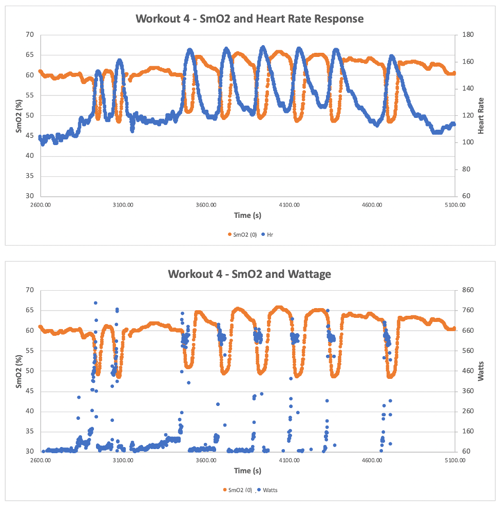Case Study: Adaptation to 5 Weeks of Training - Part 3
Introduction. Over the last few weeks a case study of 5 weeks of high intensity interval training has been completed. To refresh your memory, the athlete, a well-trained cyclist, completed five consecutive weeks of 5-10 reps of 30-40s at ~600w (30-60s rest). The athlete was able to complete at least 5 intervals per training session, however during workout 4 only 5 intervals were completed and there was a large discrepancy in how well the athlete could desaturate leading to a truncated workout, and ultimately and much better workout the following week. In this post I want to touch on some things to be aware of as a coach using Moxy, as well as some practical applications using the data. These applications will include recommendations for warm-ups, knowing when to stop an athlete’s workout.
Warm-ups. A detailed discussion of how to use Moxy to create a warm-up has been previously complete. Briefly, the purpose of a warm-up is to prime the body to perform as well as possible during a workout. Proper warm-ups should include, mobility, activation, and other dynamic drills, but more importantly they should elevate an athlete’s heart rate, and temperature, in order to improve blood flow to the working muscles. Using a Moxy to monitor warm-up, coaches can get a picture of how well an athlete is warm-up by monitoring muscle oxygenation status. The key to a proper warm-up is to push SmO2 as high as possible, giving the muscle easy access to as much oxygen as possible before completing a challenging workout. There are multiple ways to push SmO2 up during a workout. 1) ride or run at a pace that is EASY, and allows for an increase in SmO2, this occurs when delivery of oxygenated blood exceeds oxygen utilization at the tissue. 2) Complete a few short higher intensity intervals to create oxygen demand at the muscle that leads to more oxygen delivery (i.e. 3 minute interval at 80% VO2max, or 15-30s higher intensity high cadence spins), subsequent recovery must be enough to allow for SmO2 to rise. Personally, I like to start with some easy riding followed by a 3 minute interval, adequate rest, then a couple higher intensity intervals. In the case study example, the athlete was typically able to raise their SmO2 from 45-50 at rest, to 60-65%. I am not their coach but think that with a little more work placed into the warm-up, they would be able to push that SmO2 higher.
Autoregulation. The concept of autoregulation has been discussed previously, but from this case study, it is evident that during workout 4 that the athlete needed to stop their workout early. Autoregulation can come from a few different points: recovery SmO2, performance SmO2, SmO2 patterns from previous workouts, and/or a combination of all three. From previous workouts, we know that the athlete was capable of desaturating to ~30% but in this workout could only desaturate to 50%. This is a HUGE discrepancy in how much they could desaturate. Using this, it would have most likely been best for the coach or athlete to have stopped the workout at interval 2-3, as to not put too much undue stress on the athlete.

Summary. Monitoring muscle oxygenation offers tools to help prepare and athlete for challenging workouts, as well as monitoring how their physiology is responding to the workload itself. Using these values a coach can get a rich understanding of how prepared an athlete is for the upcoming workout, allowing the coach to change or tune workouts on the fly to maximize the benefits from training.
